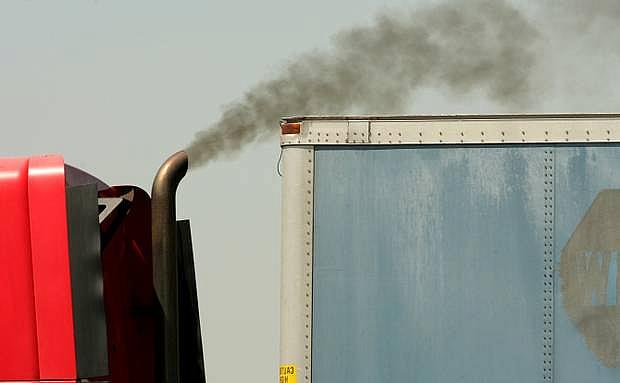POLLUTION: Microscopic particles can cause internal havoc
Between the moment when a microscopic piece of soot flies out of a tailpipe or smokestack and enters a person’s lungs, it undergoes an array of complex chemical reactions. It essentially becomes an airborne vessel that can carry hundreds of varieties of toxic compounds.
This report was produced in part with a grant from the Lucile Packard Foundation for Children's Health Journalism Fund, awarded by The California Endowment Health Journalism Fellowships at the USC Annenberg School of Journalism.
Other portions of this story:
AIR POLLUTION: Battle still on for clean air
CLEAN AIR: Reducing air pollution extends lives
CLEAN AIR: A promise still elusive for Inland region
HEALTH: Children are more vulnerable to air pollution effects

Diesel exhaust is released into the air from a big rig as it accelerates near the the intersection of Van Buren Blvd. and Etiwanda Ave. in the Mira Loma area of Jurupa Valley. STAN LIM/STAFF PHOTOGRAPHER
Between the moment when a microscopic piece of soot flies out of a tailpipe or smokestack and enters a person’s lungs, it undergoes an array of complex chemical reactions.
It essentially becomes an airborne vessel made of black “elemental” carbon that can carry hundreds of varieties of toxic compounds.
As the soot travels with sea breezes and churns above streets, homes, campuses, workplaces and shopping centers, it reacts with other pollutants in a process aided by sunlight, said Michael Kleinman, environmental toxicology professor at UC Irvine.
Kleinman has been studying the journeys and transformations of airborne particles for decades. He spent many of the Cold War years probing the behavior of radioactive fallout for the federal government.
When soot particles encounter ozone — an invisible gas created when other pollutants combine in sunlight — one of the outcomes is the creation of especially toxic oxygen-containing compounds called quinones, he said.
An epic battle begins when the particles are inhaled. The invaders are so small that they penetrate the body’s first lines of defense — the nasal passage and the lungs, which normally send in a bath of fluids to help a person cough or snort out harmful substances.
They are so tiny they pass through lung tissue and enter the bloodstream, a highway that carries them to other tissues and organs, including the brain.
The body’s immune system rallies to fight back.
“The inflammatory cells now come out,” Kleinman said. “It is almost like an army. These guys will attack anything that is foreign.”
Cells called macrophages come first. They try to engulf and digest the intruders. Then the body sends in the second line of defenders: the more aggressive neutrophils, white blood cells on a suicide mission to stop the invasion. The neutrophils make “oxygenated and nitrogen compounds that can literally burn a pathogen and destroy it,” Kleinman said.
The cellular battle, however, generates collateral damage.
The invaders may be neutralized, but free radicals — unstable atoms or molecules created during inflammation to help destroy the invading particles — can begin attacking and harming healthy cells. The process can trigger a chain reaction of cell injury.
“Free radicals are associated with cancer and heart disease, and brain disease,” Kleinman said.
Free radicals can damage fat cells and create plaque in blood vessels. Too much plaque leads to heart attacks and stroke.
The best defenses for people who can’t avoid air pollution are common-sense: minimize exposure as much as possible — avoid diesel fumes; don’t exercise when pollution levels are higher; and maintain a healthful lifestyle by eating wisely, exercising and not smoking.
This story originally ran in the Press-Enterprise on September 5, 2013.
Photo Credit: STAN LIM/STAFF PHOTOGRAPHER
